 |
The Saint of the Day
St. Thomas Becket - December 29
Prof. Plinio Corrêa de Oliveira
In Catholic Morals, there is a principle: Nemo summus fit repente - nothing very bad or very good happens suddenly. For a great evil to occur, there should be a whole series of actions that precede and prepare for it. This principle, which applies to the moral life of an individual, is also true in the history of nations, civilizations and cycles of culture. The life of St. Thomas Becket and the events that occurred after his death illustrates well how a long preparation is made for momentous historical events.
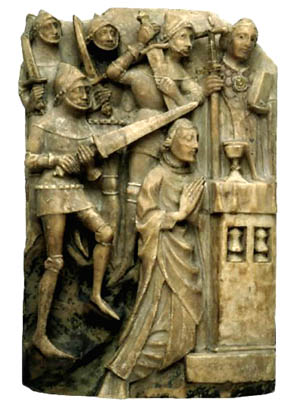
A late 15th century alabaster panel representing the martyrdom of St. Thomas Becket
|
Such an event - undoubtedly one of the most sad and shameful episodes of the History of the Church - took place in the 16th century when a massive number of English Catholics changed from the Catholic Religion to Protestantism. King Henry VIII wanted a divorce from Queen Catherine of Aragon, and the Pope would not agree to it. In 1534, The King broke with Rome and proclaimed himself the head of the Church in England.
After his rupture with Rome became definitive, only a very small number of Catholics remained faithful to the Church. Two of the most illustrious were St. John Fisher, a Cardinal, and St. Thomas More, a layman. But the great majority of Catholics scandalously and shamefully switched religions. Entire monasteries and convents, countless priests and nuns, whole institutions, universities, and works of charity entered the new sect without any apparent remorse. How can one explain a fact like that?
The English process that culminated with this separation from Rome began in the 12th century with the fight between St. Thomas Becket and King Henry II regarding the interference of the Crown in ecclesiastical affairs. A dispute between Kings and Popes on this topic already existed in that time. The Kings wanted the Catholic English Hierarchy to obey them and accept their appointments to ecclesiastical offices. The Popes, basing themselves on the divine institution of the Church, defended the Church's right to full dominium over spiritual matters, in particular over Bishops and the faithful.
The Pope has direct and immediate power over every Bishop and each one of the faithful on earth. Therefore, also over the English Bishops. The Pope's power to choose and direct Bishops displeased a certain English current of thinking that sustained the opposite. According to it, the Pope should exercise only a weak and indirect authority over the English Bishops, while the King should have a full and direct power over them.
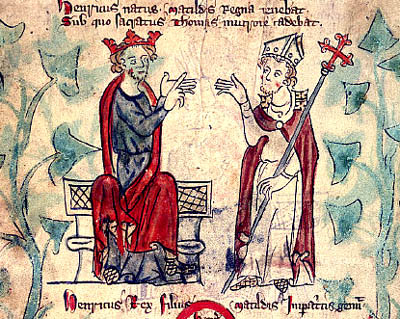
St. Thomas Becket, right, faces King Henry II in a dispute
Picture by Peter of Langtoft
|
Behind this question was a higher struggle of principles at stake. The central question in the realm of principles, rather than concrete cases was this: Should the temporal or spiritual sphere have the greater power? Should the temporal sphere obey the spiritual, or vice-versa?
In the absolute order of things, those who defended the King's rights over the English Bishops were sustaining that earthly and temporal things have more importance than religious matters, and the latter should be an instrument for the realization of the former. For this party, the end of the life of man is not heaven, but life on this earth. Therefore, the representative of the State and temporal interests should have supremacy over the Church.
In final analysis, for those who took this position, religion would be nothing more than a useful myth to keep order among the people. It would not be a revealed, objective, and absolute ensemble of truths.
On the other hand, those who believed in the Church's supremacy supported the principle affirming that things of this life exist for eternal life. It is true that the State has to deal with temporal matters. But it is also true that the State is meant to help the Church accomplish her mission. Therefore, in ecclesiastical matters, the Church has the full right and entire power to govern herself. Further, should sin be involved in a temporal affair, the Church has the right to intervene to halt its advance. In such a case, the Church has power over the State. More clearly affirmed, the State does not have the right to promulgate laws and establish institutions that are against the law of Christ.
This notion of the supremacy of the State over the Church that was adopted early on by English Kings, as well as by Kings of other countries, was designated by the Church as a grave error: Regalism. It is a revolutionary position with the same root as the modern errors of Laicism and Materialism.
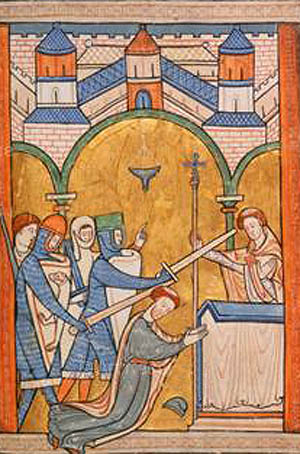
The murder of St. Thomas Becket who kneels at a side chapel of Canterbury Cathedral
|
In the 12th century, St. Thomas Becket clashed with King Henry II because St. Thomas sustained that the Pope and English Bishops could not accept the jurisdiction of the King over them. St. Thomas Becket was the Archbishop of Canterbury, the first see of England. He was, therefore, the kingdom's most important religious authority. He also was a brilliant man who had been chancellor of England before he was made Archbishop. These characteristics help us understand the enormous influence he had.
His strong opposition to the King's position greatly embarrassed Henry II, who exiled him for some considerable time. He returned to England, however, and continued to attack the erroneous policy of Henry II. Soon after his return, four agents of the King violated the sanctuary of Canterbury Cathedral and murdered St. Thomas Becket at the altar on December 29, 1170.
What were the consequences of this act? A large part of the English people took the side of St. Thomas Becket and became indignant with the King. A cult grew up immediately and people flocked on pilgrimages to the site. It reached the point that the King felt the need to make public penance before the sepulcher of St. Thomas Becket and ask forgiveness of God for what had happened.
But it is also true that a good part of the leading classes - the clergy, high nobles, intellectuals and magistrates
- continued to support the King's position and to sustain that St. Thomas Becket had acted imprudently. That is, they supported the false principle that the power of the State is superior to that of the Church.
The result was that as time passed, the State gradually invaded the religious sphere. The English ecclesiastics were either complacent with such doctrine or fearful of defending the correct doctrine. So this deleterious process continued. Three hundred years later England was still Catholic, but its Catholicity was so superficial that it was possible to throw down the Church in England as easily as one fells a tree whose roots are rotted away by termites. With a single blow, it falls to the ground. This is what happened with the Catholic Church in England.
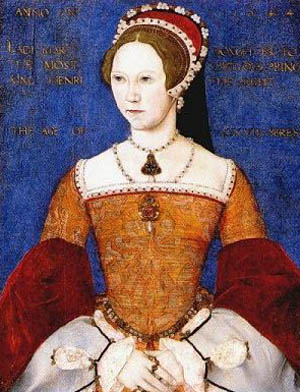
Under Mary Tudor, above, England returned
to Catholicism, only to abandon it again after her death
|
It is curious to note that this process moving toward revolt against Rome, which was pushed forward by the clergy and high nobility, had less influence among the lower nobility and people. The Catholics became a kind of Church of Silence in England. It seems, however, that even this Church of Silence was not faithful, as the following incidents reveal.
When Edward VI died at the age of 16, his half-sister Mary Tudor, daughter of Queen Catherine of Aragon, came to the throne. She married King Philip II of Spain. All England changed from Protestantism and became Catholic again. A Legate of the Pope traveled to England to give general absolution to the entire Parliament, whose members received it on their knees. It would seem that everything had returned to the correct order. But as soon as Mary Tudor died in 1558, those same bishops, nobles, and authorities who had returned to the Catholic Religion, went back to Protestantism under Elizabeth I. That is to say, everything was appearances, everything was opportunism.
It is interesting to note a parallel fact that many historians forget to mention. After his break with Rome, Henry VIII ordered that some subordinates go to the tomb of St. Thomas Becket, remove his bones from the altar, and begin a process against him. At its conclusion, he was declared guilty of lese-majesty [high treason] and his relics were burned. This fact is rarely spoken about.
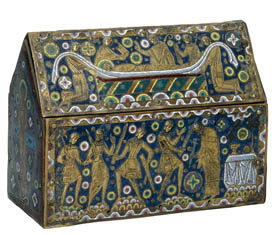
A reliquary with the remains of St. Thomas Becket found in Naples in 1800
|
This second martyrdom of St. Thomas Becket, however, constituted a true glory for him. It is the glory of being hated by those who are evil, the glory of suffering persecution for the love of Our Lord Jesus Christ. Also, it demonstrates how his example had been so magnificent that even centuries later, the revolutionaries had to destroy his relics in order to break with the Catholic Church. Even after his death, he was a barrier to the evil they wanted to do, and they had to get rid of this barrier for the heresy to grow and spread.
Nothing is more beautiful than this: a man lying in his tomb in the shadow of death who, notwithstanding, remains a vigilant sentinel against evil, impeding its advance. He held this place of honor for 400 years, thwarting England from fully embracing the error of Regalism, which finally became the heresy of Anglicanism.
Is there some analogy between the process of deterioration of English Catholicism and our own days? We see that Catholic thinking has been undermined by the Revolution, at least since the 19th century. At times by omissions, at times by concessions on doctrinal points, at times by an unjustifiable adhesion to doctrinal errors. This is what prepared the wave of Progressivism that has taken over the Catholic Church today. If a strong reaction will rise against it, we can expect every good thing. If such reaction fails to come, it is probable that after some time these people will accept the heresy. I am not speaking only about the Brazilian people, but also about any other people who do not make a strong reaction against Progressivism.
When a termite enters a piece of wood, it gnaws at it from within, leaving the external appearance. The wood appears normal to anyone looking at it. But if he puts pressure on the wood, the exterior layer breaks open and reveals the work of the worms eating away at the interior. The same is happening today with the religious edifice. There is still an exterior finish of orthodoxy, but if one pushes against it, he finds that everything is being corrupted by Progressivism, which is the Revolution inside the Catholic Church.
I have summarized for you here some historical laws. They are not laws that apply invariably to every situation, but they explain how an analogous process unfolds in many cases. These are considerations drawn from the life of St. Thomas Becket.


  | | Prof. Plinio Corrêa de Oliveira | |
The Saint of the Day features highlights from the lives of saints based on comments made by the late Prof. Plinio Corrêa de Oliveira. Following the example of St. John Bosco who used to make similar talks for the boys of his College, each evening it was Prof. Plinio's custom to make a short commentary on the lives of the next day's saint in a meeting for youth in order to encourage them in the practice of virtue and love for the Catholic Church. TIA thought that its readers could profit from these valuable commentaries.
The texts of both the biographical data and the comments come from personal notes taken by Atila S. Guimarães from 1964 to 1995. Given the fact that the source is a personal notebook, it is possible that at times the biographic notes transcribed here will not rigorously follow the original text read by Prof. Plinio. The commentaries have also been adapted and translated for TIA's site.
|
Saint of the Day | Home | Books | CDs | Search | Contact Us | Donate

© 2002- Tradition in Action, Inc. All Rights Reserved
|
 |

|